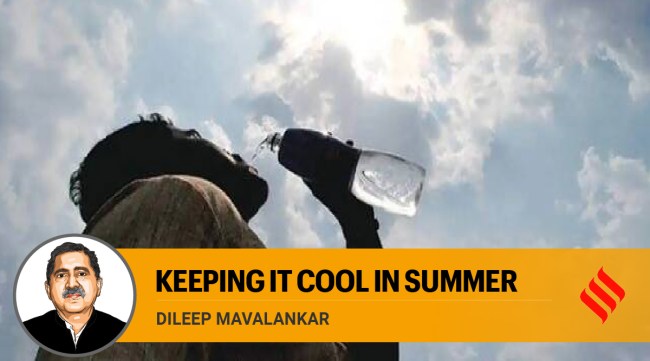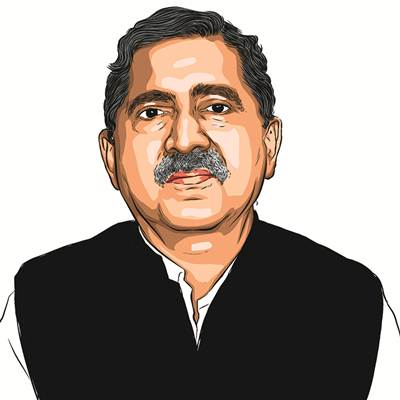Opinion Maharashtra heatstroke deaths: Protecting the vulnerable this summer
Indian cities and towns need heat action plans to deal with health challenges posed by global warming
 In India, as most people are used to hot weather, we have not paid much attention to heat-related mortality and morbidity.
In India, as most people are used to hot weather, we have not paid much attention to heat-related mortality and morbidity. The tragic death of 14 people in Navi Mumbai last week due to heat stroke in a gathering in open ground is a grave reminder of how quickly heat can kill, even in early summer. Peak summer is still a month away. The IMD has predicted a hotter summer this year and we have to take care to prevent as many deaths and heat stroke cases throughout the country as possible. This is doable. Ahmedabad was the first city to start a threshold-based heat action plan (HAP) in 2013, learning from the devastating heat wave of 2010 when, in one week, 800 additional deaths happened in the city.
Heat stroke and deaths due to it is not new. Hippocrates makes a mention of it. Heat stroke deaths have plagued various armies for centuries. The prevention of the effects of heat has been described in old texts and followed by armies for a long time. The recent revival of interest in heat waves happened after a devastating heat wave in Chicago in 1995 and the European heat wave of 2003. Global climate change has added to the urgency of fighting heat waves.
In India, as most people are used to hot weather, we have not paid much attention to heat-related mortality and morbidity. Traditionally, most cultures in India have words to describe heat stroke — such as “loo” in Hindi and other languages. People know that it is a serious condition. But, with the country having several other pressing tasks and the weak national commitment to health in general, heat stroke has not been given due importance. With increasing climate change and global warming, summer temperatures have started to increase rapidly. In the past few years, summer has advanced by about a month. The IPCC predicts that over the next 80 years, the climate is going to warm up rapidly and relentlessly. The World Meteorological Organisation has declared that the past six years have been the hottest globally, indicating the increasing pace of global warming. Hence, it is imperative that all cities, districts and villages in India prepare for heat waves.
The Ahmedabad heat action plan which was drawn from such plans developed globally and under guidance from the WHO and WMO includes five components which are pretty simple and any city can implement them. The first is the prediction and alert system. The IMD now predicts the temperature level for the next five days in more than 500 cities and all districts of India. The local city or district governments have to take the historical temperatures of the cities and issue a red alert if it is in the 99th percentile, an orange alert if it is in the 95th percentile and above, and a yellow alert if is the 90th percentile and above. These historical data can be obtained from the local IMD office. The other way is to correlate the daily all-cause mortality with daily temperatures for the last 15-20 years. This should be followed by setting up cut-offs when the mortality line rapidly increases. Once this alert system is in place, the next step is to make people aware of the actions to be taken by them and the government at various levels of alert. During the summer season, especially if there is a red or orange alert, people must carry water while going out and cover their heads or use an umbrella to prevent direct exposure to sunlight. Direct exposure to sunlight between 11am and 4pm, combined with the lack of water could prove fatal.
Many other simple precautions can prevent heat stoke such as avoiding exertion during peak heat hours, taking frequent rests if you have to work and drinking plenty of water. The health system should be prepared in the summer to quickly and correctly treat heat stroke cases. Spraying water and fanning is the simplest way to cool the patient. Ice or cold water can also be used for the purpose. Other measures could be making water and shade available in public places and construction sites.
Long-term measures like greening of cities by increasing the tree cover, painting roofs white (cool roofs) to reflect sunlight and heat, and use of low-energy cooling devices such as fans and coolers will also help to reduce the effect of increasing heat. Special attention should be given to old and those with comorbidities as they have a greater risk of a heat stroke attack, even at home. Hence, the government and people must focus on the vulnerable sections. Those who have to work in the open — traffic police, labourers, street vendors — must be made aware of ways to protect themselves from heat stroke.
Finally, each city and district should appoint a “heat officer” who will ensure that the heat action plan is prepared and implemented. We have to measure the impact of the heat on mortality and morbidity. The best way to do that is to capture and analyse all-cause mortality and hospitalisation in every city and correlate it with daily maximum and minimum temperatures. This will inform authorities if mortality and morbidity are within the usual limits — currently, no city except Ahmedabad conducts such an exercise. The annual review of heat action plans will tell what action is taken and what needs to be done. The plan has to be revisited every year and revised when new features are required to protect people. Such simple measures, if implemented systematically, will protect many people from heat wave-related mortality and morbidity. This requires inter and intra-departmental coordination and top-level commitment. Let’s all join in this effort and ensure that the most vulnerable are protected this summer.
The writer is director, Indian institute of Public Health, Gandhinagar



